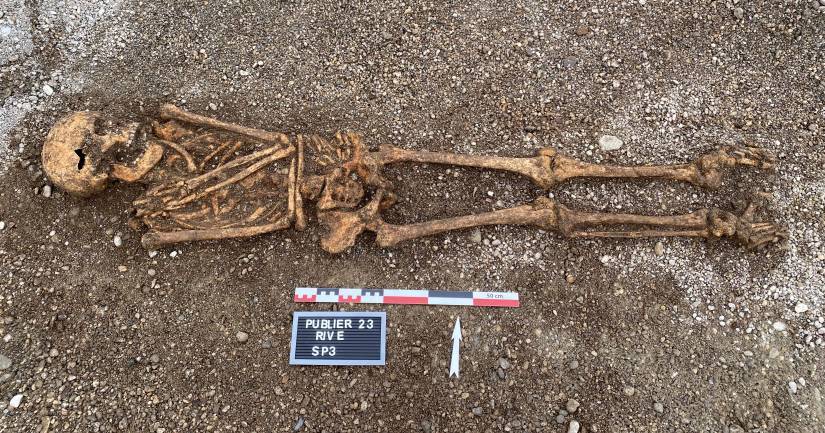During development work, avenue de la Rive in Publier (Haute-Savoie) human bones were discovered in February 2023.
Looking back on the discoveries:
1 February 2023 : first discovery of human bones during work in progress of the redevelopment of the RD1005 at 1099 avenue de la Rive in Publier (Haute-Savoie). The police station of Thonon-les-Bains was the relay of the town hall of Publish to transmit the information. The drivage was quickly completed.
13 February 2023 : Second discovery of human bones about 30 meters from the previous one. The information is transmitted to the
Regional Directorate for Cultural Affairs Auvergne-Rhône-Alpes
- regional archaeology service. The area is immediately secured, a meeting is organized on 15 February.
With regard to these two reports, the state of the archaeological knowledge of the area, the plans and cuts of the project, a protocol of field intervention is put in place in order to verify the nature and the degree of conservation of the archaeological remains uncovered.
On 1 and 2 March, an archaeologist from the Regional Archaeology Service conducted an operation on a surface of about 40 m² where five burials were uncovered; three adult individuals and two young individuals according to the first field observations.
©DRAC Auvergne-Rhône-Alpes - Regional Archaeology Service
The skeletons collected are currently kept in an archaeological repository of the State. These bones must be inventoried and conditioned.
Biological studies may complement the taphonomic observations, that is to say the processes of evolution or degradation of the remains buried in the ground, carried out in the field. They would also identify pathologies that have affected individuals or possibly the cause of their death.
Finally, dating to
Carbon 14
may be carried out in order to clarify their chronology since no object associated with the burials has been identified.
The current working hypothesis is that these are individuals who lived in the early Middle Ages. Indeed, in the 1970s, when the low-income housing units were built, burials had been discovered, funeral rites identified and the archaeological furniture associated with the deceased had made it possible to characterize the chronology.
Moreover, it was this discovery that motivated the archaeological protection of the Shore sector by establishing an area of presumption of archaeological prescriptions involving the consultation of the DRAC-
regional archaeology service
prior to the issuance of a land use permit.
Work continues on areas outside the supposed perimeter of the cemetery. However, the placement of buried containers and the rehabilitation of the roadway around the "Résidence de la Rive" could put at risk other burials and should be the reason for the setting up of preventive archaeology digs.
Scientific control: DRAC Auvergne-Rhône-Alpes, Regional Archaeology Service
photo credits: ©DRAC Auvergne-Rhône-Alpes - Regional Archaeology Service


